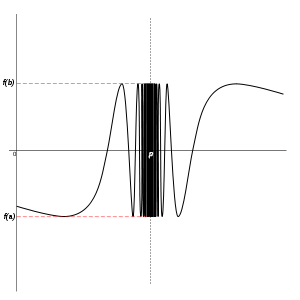- Oscillation (mathematics)
-
In mathematics, oscillation is the behaviour of a sequence of real numbers or a real-valued function, which does not converge, but also does not diverge to +∞ or −∞; that is, oscillation is the failure to have a limit, and is also a quantitative measure for that.
Oscillation is defined as the difference (possibly ∞) between the limit superior and limit inferior. It is undefined if both are +∞ or both are −∞ (that is, if the difference between the superior and inferior limits of the sequence or function is in one of the indeterminate forms +∞ + (-∞) or -∞ - (-∞)). For a sequence, the oscillation is defined at infinity, it is zero if and only if the sequence converges. For a function, the oscillation is defined at every limit point in (−∞, +∞) of the domain of the function (apart from the mentioned restriction). It is zero at a point if and only if the function has a finite limit at that point.
Contents
Examples
- 1/x has oscillation ∞ at x = 0, and oscillation 0 at other finite x and at −∞ and +∞.
- sin (1/x) (the topologist's sine curve) has oscillation 2 at x = 0, and 0 elsewhere.
- sin x has oscillation 0 at every finite x, and 2 at −∞ and +∞.
- The sequence 1, −1, 1, −1, 1, −1, ... has oscillation 2.
In the last example the sequence is periodic, and any sequence that is periodic without being constant will have non-zero oscillation. However, non-zero oscillation does not usually indicate periodicity.
Geometrically, the graph of an oscillating function on the real numbers follows some path in the xy-plane, without settling into ever-smaller regions. In well-behaved cases the path might look like a loop coming back on itself, that is, periodic behaviour; in the worst cases quite irregular movement covering a whole region.
Continuity
Oscillation can be used to define continuity of a function, and is easily equivalent to the usual ε-δ definition (in the case of functions defined everywhere on the real line): a function ƒ is continuous at a point x0 if and only if the oscillation is zero;[1] in symbols, ωf(x0) = 0. A benefit of this definition is that it quantifies discontinuity: the oscillation gives how much the function is discontinuous at a point.
For example, in the classification of discontinuities:
- in a removable discontinuity, the distance that the value of the function is off by is the oscillation;
- in a jump discontinuity, the size of the jump is the oscillation (assuming that the value at the point lies between these limits from the two sides);
- in an essential discontinuity, oscillation measures the failure of a limit to exist.
This definition is useful in descriptive set theory to study the set of discontinuities and continuous points – the continuous points are the intersection of the sets where the oscillation is less than ε (hence a Gδ set) – and gives a very quick proof of one direction of the Lebesgue integrability condition.[2]
The oscillation is equivalence to the ε-δ definition by a simple re-arrangement, and by using a limit (lim sup, lim inf) to define oscillation: if (at a given point) for a given ε0 there is no δ that satisfies the ε-δ definition, then the oscillation is at least ε0, and conversely if for every ε there is a desired δ, the oscillation is 0. The oscillation definition can be naturally generalized to maps from a topological space to a metric space.
Generalizations
More generally, if f : X → Y is a function from a topological space X into a metric space Y, then the oscillation of f is defined at each x ∈ X by
See also
References
- ^ Introduction to Real Analysis, updated April 2010, William F. Trench, Theorem 3.5.2, p. 172
- ^ Introduction to Real Analysis, updated April 2010, William F. Trench, 3.5 "A More Advanced Look at the Existence of the Proper Riemann Integral", pp. 171–177
Categories:- Real analysis
- Limits (mathematics)
- Sequences and series
- Functions and mappings
Wikimedia Foundation. 2010.



